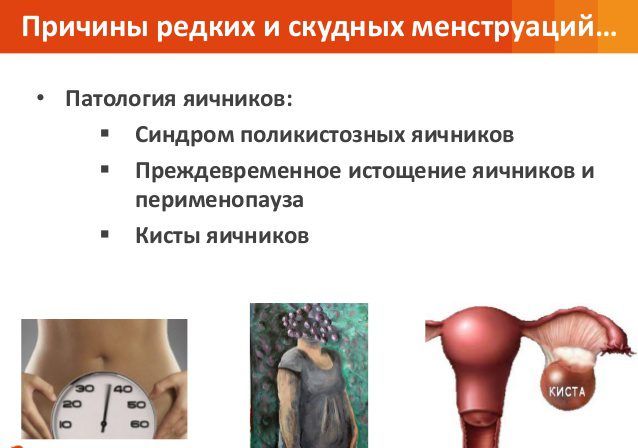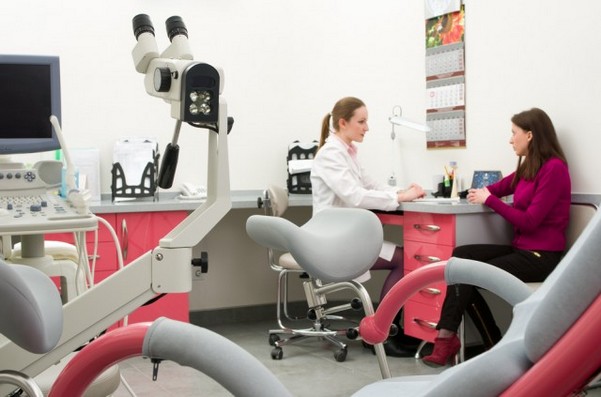Having scanty periods: what is the cause of this condition. Restoration of the menstrual cycle after childbirth.
The female body is a mystery that only nature can solve. The features of changes that can occur after 40 years can be of different nature. During this period, active hormonal changes in the body occur and problems with the regularity of menstrual flow may occur. If you notice irregular periods, dizziness, hot flashes and unreasonable migraines, this may be a hint that menopause is approaching and all these symptoms are nothing more than the beginning of menopause.
However, in some cases, interruptions in menstruation may indicate pathological processes in female body. Therefore, in one case or another, it is worth consulting with a doctor who will prescribe the necessary tests and examinations and subsequently decide how to properly resolve the problem.
The main causes of menstrual irregularities in women after 40 years of age and ways to eliminate them
Why changes occur in the menstrual cycle in women after forty years, the answer may be the most unexpected - this is due to hormonal changes and a sharp decrease in estrogen production. In such a situation, the probability of fertilization of the egg is reduced to a minimum, therefore, this indicates the extinction of menstrual functions.
However, after menopause begins, female organs should function at the same level, but as practice shows, many of them fail temporarily and suspend their work for a certain period of time. There are also situations when it is possible to restore their functionality only after preliminary targeted treatment. In this case, menstruation begins to fade, however, there are very rarely situations when it can recover for a while.
It is also worth noting that at the age of 40 and above, other health problems may arise, during which menstruation also stops. These phenomena are not caused by hormonal changes and may be as follows:
- Psychogenic reason. Severe stress can cause problems menstrual cycle and as a result, delayed menstruation. It is worth noting that even with age, a woman does not cease to react very sharply to the environment and worry about certain things and situations. Consequently, the menstrual cycle also reacts sharply to this and responds with monthly delays.
Here it is also worth taking into account general indicators of physical health as much as possible. This is due to the fact that mental emotions most directly affect a woman’s overall health. Pre-menopausal age always means additional emotions and stress, and it is better to endure them at a young age than after forty years.
- Emotions. If menstruation does not come for a long time or is absent altogether, this may be a consequence of very strong impressions or emotions. By the way, it is worth noting that this emotional overstrain can be both negative and positive.
- Neurogenic causes. It often happens that the menstrual cycle may be disrupted due to various psychological stresses that may arise at work, at home or in other places. This also includes very important events in the lives of our children. The mother endures this experience so acutely that menstruation after 40 years may stop for a while.
- Physical activity, especially excessive for a woman’s weight category. Many women, after having fulfilled the main function - giving birth to children, stop paying attention to the weights they lift. However, this should be monitored at any age, since forty years is a fairly old age and severity can be reflected in a decrease in menstrual function and, as a result, in various female diseases.
- Various pathologies of the genital organs in women are a cause that can occur latently at a young age and make itself felt only after forty years. Menstruation begins to occur intermittently and at this age there is a significant risk of developing various pathologies that are dangerous not only to general health, but also to a woman’s life.
The most common diseases include the following:
- ovarian cysts of multiple or single nature;
- endometriosis;
- fibroids of the uterine cavity;
- chronic adnexitis;
- endometritis.
As for various gynecological interventions, abortion, removal of polyps or other manipulations can also cause the absence of menstruation for a month or more.
- Chronic diseases of the body as a whole. It is worth noting that if a woman’s body has inflammatory processes that are chronic in nature, then this can also cause a delay in menstruation. In order to exclude this condition as much as possible, it is necessary to visit a doctor on time, who will prescribe all the necessary tests and examinations in order to exclude as much as possible the presence of pathological processes.
As for the gynecologist, it is worth undergoing an examination once a year, and if any diseases are naive, this process should be repeated once every six months.
- The cause of the delay may be problems with the functioning of the woman’s endocrine system. The thyroid gland is most directly connected to the gynecological system, therefore, with its reduced functionality, interruptions in the menstrual cycle can be observed.
- Obesity or poor diet of a woman. This factor can directly influence interruptions in menstruation. The diet should include all the necessary nutrients and, as much as possible, exclude foods that contribute to the development of pathologies such as excess weight or cholesterol accumulation. The ovaries, like no other organ, react sharply to a deficiency of vitamins or an oversaturation of harmful acids, therefore, the menstrual cycle is also disrupted due to the malfunction of its main organ.
- Medicines. There are some types of medications that can inhibit the process of menstruation. However, in order to avoid this, you should take medications only after consulting your doctor. If you are taking medications of this type and notice a temporary delay in your periods, then after stopping them, the cycle is usually restored.

If you notice a decrease in the volume of menstrual flow, you should definitely consult with your doctor, after which it will be possible to determine the exact cause of the delay or cessation of menstruation in a woman after forty years.
If you are approaching the age of forty, then you should take care in advance to ensure that this period passes with minimal discomfort for the woman. To do this, you should not succumb to stressful situations and carry very heavy weights. However, if the field of activity is associated with such nerve-wracking projects, then it is worth thinking about changing the field of employment in order to prolong your career as much as possible. women's health and longevity.
What changes can a woman face at 45 years of age?
To understand what happens to the female body after forty years, it is worth clearly understanding that this age is characterized by the approach of menopause. Consequently, hot flashes, menstrual irregularities and poor health should first of all be regarded as a normal physiological state upon the onset of menopause.
At the age of forty-five, the interval between monthly bleeding gradually increases, and the discharge itself becomes more scanty. It is precisely at this age that this situation becomes the norm. However, there is an alarming signal if at this age your periods become more heavy or bleeding begins in the middle of the cycle and lasts more than seven days, you should urgently consult with a highly qualified specialist in order to maximally exclude the occurrence of any pathologies.
Regarding the period of 40-45 years for a woman, it is worth noting that exactly this stage life is a real premenopause. During this period, the activity of the ovaries begins to gradually decrease and estrogen is accordingly not released in the required quantity. Menstruation is delayed, discharge is scarce, and you can also notice how menopause is gradually approaching. As a rule, during this period chronic diseases may worsen or new pathologies associated with intense hormonal changes in the female body may arise.

As for the individual tolerance of this condition, it is worth noting that each woman tolerates it differently. Some people suffer from migraines and intense hot flashes, while others simply feel slight dizziness, which very quickly passes without a trace. It all depends on the woman’s immune system, as well as on the individual characteristics of her body.
If we talk about external given by women after the age of forty, it is worth noting that hormonal changes most directly affect the condition of a woman’s skin. Due to the low production of estrogen, regeneration processes slow down significantly and the skin may, for the most part, become covered with wrinkles and appear flabby. However, hormone replacement therapy in the form of special injections or tablets helps to cope with all these shortcomings. Taking these medications on your own is strictly contraindicated; the need for their use should be initially discussed with your doctor. This is due to the fact that the wrong dosage hormonal drugs can cause a variety of diseases, including the occurrence of tumor processes.
For some women, the period is fraught with problems in the intimate sphere. Due to the fact that hormones are not stable, symptoms such as vaginal dryness may appear. This is also due to a lack of estrogen. The woman begins to experience a certain discomfort, which is not entirely compatible with the pleasant sensations during sex.
The mucous membranes practically do not perform the functions of protecting the genital area, therefore, various genitourinary infections can occur.
The age of forty for a woman is the beginning of a period known as premenopause.
Every woman should monitor her health and not ignore the manifestation of such a hormonal disorder as scanty periods. Since they may be the first sign of reproductive health problems.
With the appearance of scanty periods, in addition to the pain that accompanies normal menstruation, specific symptoms appear:
- nausea;
- severe headache;
- diarrhea, constipation;
- increased blood pressure;
- heart pain;
- numbness of the limbs.
What does it mean?
Scanty menstruation or hypomenorrhea is a menstrual disorder in which scanty discharge is observed instead of menstruation. On average normal bleeding last from 3 to 5 days with an interval of 21 - 38 days. The amount of blood varies from 50 to 150 ml.
If there is less discharge, then we are talking about hypomenorrhea. The color of menstruation can be dark, or, conversely, light. At the same time, the woman’s well-being worsens, headache, nausea, and back pain appear.
Scanty periods
The appearance of scanty brown discharge is a sign of dysfunction of the reproductive system. The dark color indicates the coagulation of some of the blood when leaving the uterine cavity.
Sometimes brown discharge are a hereditary trait. They do not affect a woman’s health or pregnancy.
At a young age and after 40 years
IN early period Natural changes occur in a woman’s body. During the period of formation of a normal menstrual cycle, hypoestrogenism may be observed and until the ovaries are fully formed, menstruation is scanty. But at the end of puberty they must reach the physiological norm.
After 40, scanty periods can be caused by the onset of menstruation, which provokes fluctuations in sex hormones, which leads to a change in the amount of discharge in any direction. This can be full bleeding or scanty irregular menstruation. In such cases, treatment is not carried out. Therapy is recommended only for hot flashes and menopause.
In early pregnancy
At the beginning of pregnancy there is a slight discharge.
The reasons may be the following:
- the fertilized egg did not reach the right place, so the hormonal levels did not have time to adjust;
- detachment of the fertilized egg has occurred, and the body independently holds it in the uterus;
- sometimes blood accompanied by aching pain in the lower abdomen is a sign of spontaneous abortion or ectopic pregnancy.
After a delay
If there is a minimal delay in menstruation, and then small discharge appears, it is necessary to do. This excludes ectopic pregnancy, during which spotting bleeding of the inner layer of the uterus occurs.
Improper development of pregnancy causes fetal rejection. The only manifestation of this is spotting, which is why scanty periods are a sign of disorders in the body.
If the test is negative
 During puberty, this phenomenon is not a dangerous sign. But in adulthood there are a number of reasons:
During puberty, this phenomenon is not a dangerous sign. But in adulthood there are a number of reasons:
- ectopic pregnancy;
- various pathological disorders;
- sudden weight loss;
- breastfeeding period;
- overvoltage.
After childbirth
For a long time after childbirth, women experience bloody discharge called lochia. They resemble menstruation. After 3 - 4 days they decrease in number. Bloody discharge continues for up to 10 days.
After 2 weeks, the lochia lose color and take on a slimy appearance. If you examine the discharge under a microscope, red blood cells are not detected, mainly epithelial cells, leukocytes, and detritus. Sometimes the discharge lasts up to 42 days. But distinctive feature from bleeding is a decrease in their volume every day.
If a woman is breastfeeding, then scanty periods are the norm. This is explained by the production of large amounts of the hormone prolactin.
After scraping
Curettage is a means of treating bleeding. After curettage, slight bleeding may be observed, which is considered quite normal, since the surface bleeds. Over time, the endometrium becomes covered with epithelium and blood loss decreases.
Increased bleeding indicates remnants of pathological tissue in the uterus.
Possible reasons
Let's look at other reasons that lead to scanty menstruation in a woman.
Taking birth control pills
Hormonal medications contain estrogen or progesterone. These substances affect the menstrual cycle and prevent. Therefore, insufficient periods while taking OCs do not necessarily indicate abnormalities.
Cancel OK
Stopping taking OCs requires the ovaries to restore their functions. This takes some time. There may be some slight discharge at first, but over time the function is restored.
Sometimes there are scanty periods after. The drug contains progesterone, which prevents the production of estrogen. The endometrium increases gradually, and at the beginning this causes scanty discharge, for a maximum of 3 cycles. Then everything returns to normal.
Hormonal disorders
Menstrual function is disrupted due to a lack of hormones in the body. The most common changes are endocrine disorders, diabetes mellitus, and the lactation period.
Gynecological diseases and other causes
The cause of scanty discharge may be gynecological diseases:
- diseases of the uterus (inflammation, cancer, endometriosis, fibroids);
- ovarian dysfunction (inflammation, hormone imbalance);
- tuberculosis of the genital organs.
Other reasons:
- Genetic features. If this is a normal phenomenon in a woman’s family, no deviations are observed.
- Emotional factor. Positive or negative experiences and stress affect the functioning of the ovaries.
- Harmful work with radiation or chemicals.
- Metabolic disorders.
Carrying out diagnostics
If you're menstruating meager reasons, then the degree of disease progression is predicted by the following stages of examination:
- Compilation of the patient's medical history (oral interview).
- Gynecological examination.
- Carrying out analyzes and cultures.
- Polymerase chain reaction.
- Urine and blood analysis.
- Ultrasound of the genital organs, uterus.
- Endometrial biopsy.
Treatment methods
Treatment depends on the causes of scanty discharge identified during the examination:
- Drug therapy with progesterone, vitamin complexes, antibacterial and antimicrobial drugs.
- Surgery is required for a pituitary tumor.
- In the absence of physiological indications, nutrition and lifestyle are adjusted, and the psychological state improves.
Appeal to traditional medicine
- Onion decoction. Boil two kilograms of onions in three liters of water. Take 200 grams before meals.
- Calendula tincture. Take 2 tablespoons per liter of water. Take 200 grams three times a day.
- Herbal mix. In equal proportions, take rue leaves, golden mustache, and parsley seeds. Make a mixture at the rate of 1 tablespoon per liter of boiling water, boil for 15 minutes. Drink one glass a day in three doses.
Means traditional medicine are used as an auxiliary method of treatment.
Prevention
Measures to prevent hypomenorrhea include the following:
- normalization of lifestyle;
- avoidance of abortion;
- treatment of chronic diseases of the uterus and appendages;
- eliminating stress;
- physical activity;
- walking;
- maintaining normal hormonal levels;
You should know that excessive physical activity leads to menstrual irregularities and can lead to absence of menstruation.
For many women after 40 years, the menstrual cycle undergoes changes, which may be associated with physiological changes or with the development of pathology of the reproductive system. At this age, women may notice both scanty blood discharge from the vagina and heavy bleeding, which, moreover, can be observed twice in one month.
To understand the reasons for scanty periods after 40 years, you need to know: what hypomenorrhea is and the reasons for its occurrence.
After the development of menstrual function and until its complete extinction, every healthy woman has a menstrual cycle, which normally lasts 21–36 days. Each cycle ends with the beginning of menstruation. The amount of blood released during this period should not exceed 150 milliliters, but should not be less than 60 milliliters. If blood loss is less than 60–50 milliliters, then this condition is called hypomenorrhea (scanty periods).
Quite often, women in their forties experience not only scanty periods, but also a reduction in their duration (oligomenorrhea). This is the first signal for the imminent complete absence of menstruation, that is, the onset of amenorrhea.
Causes of hypomenorrhea
The physiological reasons for the appearance of scanty periods are the constitutional characteristics of the female body. Women who are naturally excessively thin or, on the contrary, large, plump, are more prone to developing this kind of menstrual irregularities.
Pathological causes of this menstruation disorder (in this case, timely treatment is required):
- pathology of the ovaries and pituitary gland with dysfunction of the regulation of the menstrual cycle;
- endometriosis – inflammation of the endometrium of various origins;
- frequent intrauterine manipulations (abortions and diagnostic curettages).

Factors predisposing to the development of hypomenorrhea:
- uncontrolled use of hormonal contraceptives;
- infections of the reproductive system;
- malnutrition, as a result of which anemia develops (decrease in the level of hemoglobin in the blood), metabolic disorders in the body and hypovitaminosis (lack of vitamins for the normal functioning of all body systems);
- nervous tension, chronic stress;
- diets for weight loss, which are aimed at achieving results in a short period of time;
- diseases of the endocrine system;
- long-term exposure to radioactive radiation, harmful chemical compounds and poisons on the body (intoxication of the body - both acute and chronic).

Signs of hypomenorrhea
IMPORTANT! If you have weakness and often get sick!
If you want to get rid of warts, you need to use Elena Malysheva’s simple advice to eliminate the cause of the appearance of new warts.

40 years is an age mark that frightens some women: menopause should not yet occur (it should begin no earlier than 45-50 years), but its approach can already be noticeable by a change in the nature of menstruation. At the same age, there is a peak risk of uterine cancer, endometriosis and other life-threatening pathologies, in which cycle irregularity, changes in blood volume, and delay may also be observed. Let's look at how to distinguish them and when to sound the alarm below.
Heavy periods after 40
If before your 40th birthday your periods lasted 5-7 days, during their entire period you used a maximum of 10 pads per 4-5 drops, and now they are “flooding”, you need to urgently visit a gynecologist. This may be a manifestation of the oncoming menopause, or perhaps a symptom of one of the following pathologies:
The pathology manifests itself as irregular menstruation with the release of large amounts of blood and mucus, which is accompanied by intense pain in the lower abdomen.
- menstruation occurring with particular irregularity;
- volume of bleeding more than 80 ml during menstruation;
- severe pain during bleeding.
Cancer of the uterus, which is more often found in such women:
- who started late sex life,
- who started their periods before age 11,
- who had an irregular cycle in their youth,
- obese,
- who gave birth to only one child or who did not give birth at all.
- Uterine fibroids are a disease of a tumor nature, which most often develops at the age of 35-40. Risk factors for this pathology are abortions, long-term use birth control pills, chronic inflammatory processes in the ovaries and fallopian tubes.
Endometriosis
This is the movement of the mucous layer of the uterus to other organs (when menstruation arrives, all these areas begin to be rejected, so bleeding is profuse). This disease is characterized by:
Pathology develops in those who have had several abortions or curettages, who use douching and/or PA during menstruation.
The pathology manifests itself not only by heavy bleeding during the menstrual period, but also by the appearance of blood on the pad and in the middle of the cycle. If the muscle tumor is large, you will also experience frequent urination, constipation, weakness and dizziness, which occur due to a decrease in hemoglobin.
Heavy menstruation after 40 years may have another etiology that is not the “norm”.
Scanty periods
A decrease in the frequency and volume of blood secreted after 40 years may be a sign of perimenopause - the period that precedes menopause itself and develops as a result of decreased ovarian function. This period is also characterized by other symptoms:
- hot flashes;
- dizziness;
- attacks of rapid heartbeat;
- decreased libido;
- increased sweating;
- weakness;
- frequent mood changes;
- sleep disturbance.
The skin becomes dry, wrinkles deepen, hair turns gray and begins to fall out rapidly, and the feminine contours of the figure are lost. Gradually, burning, itching and dryness occur in the external genitalia, involuntary urination, and menstruation becomes increasingly shorter.
If at the same time pain appears on one or both sides of the pubis, a high basal temperature does not drop before menstruation, but lasts more than 6 days, you need to consult a doctor, because both oncological and inflammatory pathologies of the organs of the reproductive system can manifest themselves.
Delay after 40 is not always pregnancy
If menstruation stops after the symptoms described above, such as hot flashes, mood swings, dry skin and hair, this is most likely the onset of menopause. But this symptom can also be a sign of:
- Pregnancy. In this case, changes in taste, perception of smells, nausea, swelling of the breasts and other signs of conception are noted.
- Psychogenic disorders associated with stress, resistance to which only decreases with age.
- “Female” diseases: chronic inflammation of the endometrium, ovaries or appendages, conditions after removal or curettage.
- Chronic pathologies of internal organs: liver cirrhosis, urolithiasis, blood pathologies, diabetes mellitus, any operations, infectious diseases.
- Conditions after severe respiratory tract diseases: influenza, bronchitis, ARVI.
- Endocrine disorders, especially thyroid pathologies.
- Malnutrition, when there is not enough protein or fat in a woman’s body (at this age, adaptability and interchangeability of internal resources decreases).
- Medications: Cerucal, levodopa, opiates, antipsychotics, hormones for the treatment of endometriosis.
Other cycle disorders
Particular attention should be paid to the following symptoms:
- a woman is 45 years old or older, and her menstrual intensity does not decrease or the interval between them does not increase;
- after a 4-6 month absence, “menstruation” of any nature and duration reappeared;
- in addition to changes in the menstrual cycle, signs such as bloating appeared; heartburn; constipation; pain, discomfort or heaviness in the suprapubic abdomen.
If they occur, you need to contact a gynecologist. He will prescribe an ultrasound of the reproductive organs, the level of female sex hormones and hormones associated with them. The main thing at this age is to exclude cancer of the cervix, endometrium and ovaries.
Treatment
You need to know that frightening disorders of the menstrual cycle associated with the decline of ovarian function have now been learned to be treated with hormones, hormone-like herbal remedies and homeopathy. Such drug therapy, allowing not a sharp, but a gradual decrease in hormones, sets the following goals:
- normalize menstrual bleeding;
- eliminate autonomic disorders (sweating, hot flashes, rapid heartbeat);
- normalize the emotional background;
- prevent a critical disorder of lipid metabolism;
- increase the saturation of bones with mineral salts, as a result of which their fragility will decrease;
- improve the condition of the skin and mucous membranes.
And if synthetic hormonal medications have a wide list of contraindications and side effects, and also increase the risk of developing diseases of a tumor nature, then herbal medicines and homeopathy do not carry such risks. But the latter can only be used at the very beginning of the menopausal period.
Scanty periods do not cause many problems and, as a rule, women pay little attention to them. Often a woman does not particularly attach importance to the importance of the nature of this discharge, content with the fact that menstruation comes on time and corresponds to cyclicity. And in vain, since the amount secreted during menstruation is of great importance and allows us to assess the functionality of the reproductive organs. A disruption of the cycle, when blood loss occurs with a significant decrease from the accepted norm (less than 50 ml), is called hypomenorrhea in the science of gynecology.
Reasons after 40 years
Hypomenorrhea is characterized by discharge as blood drops or simply traces of blood with a brown tint. The duration of menstruation is also reduced, which is a sign of oligomenorrhea or the onset of amenorrhea with a complete cessation of menstrual symptoms. Scanty periods may be a consequence of the formation of the reproductive system or, conversely, be evidence of the onset of menopause in a woman. Also, the occurrence of scanty periods can serve as a sign of a pathological disorder in the reproductive system. The treatment of this deviation directly depends on the factors that caused it.
Scanty periods signal disturbances in the natural processes occurring in the reproductive sphere of women. Being directly dependent on female age, the reasons can differ significantly from each other and have not only a character inherent in the pathological process, but have an absolutely physiological nature. For example, in youth, when primary menstruation has already occurred, and the cycle itself remains unsettled, for one year menstruation may not be cyclical and appear intermittently, and they will also have rather insignificant discharge. Menstruation during this period may occur only a few times throughout the year and, as a rule, will have the character of scanty periods. There is no need to react violently to such violations, since everything will return to normal within one year. If this does not happen over a long period, and the cycle remains irregular with scanty discharge, we can safely draw conclusions about menstrual dysfunction.
 Scanty monthly discharge at the time of the decline of a woman’s reproductive functions during premenopause can be safely attributed to physiological reasons. This period of menopause is a preliminary stage before the complete cessation of menstruation, and lasts on average up to 2 years. Physiological reasons for scanty periods during this important transition period in a woman’s life may be present, but they are not mandatory.
Scanty monthly discharge at the time of the decline of a woman’s reproductive functions during premenopause can be safely attributed to physiological reasons. This period of menopause is a preliminary stage before the complete cessation of menstruation, and lasts on average up to 2 years. Physiological reasons for scanty periods during this important transition period in a woman’s life may be present, but they are not mandatory.
The scanty manifestation of menstruation is divided into the primary form of hypomenorrhea, in which a woman has never had full menstruation with a normal amount of discharge. Typically, this pathology is found in young teenage girls during adolescence, especially if they begin to limit themselves in nutrition in order to lose weight. These deviations can also occur in the case of congenital anomalies in the unformed reproductive system, as well as due to delays in general development or in the development of the genital organs, as well as with an asthenic physique.
Secondary hypomenorrhea occurs when a woman’s menstruation was normal, and then, for a number of reasons, began to be scanty.
Main symptoms
Hypomenorrhea often does not show clear symptoms and a woman may not show concern about this abnormality for a long time. The appearance of scanty menstrual discharge often even suits women, simplifying the hygienic care of the genitals during this period. Minor bleeding may not even be mistaken for menstruation, but ignored, although such a violation of reproductive functions has a number of special signs, for example:
- feeling unwell;
- the appearance of persistent headaches;
- nagging pain in the chest may occur;
- vomiting and nausea;
- nosebleeds;
- unstable psycho-emotional state.
 The most common symptoms inherent in this condition include pain in the pelvic area, which has the nature of spasms and is quite intense, as well as the appearance of pain in the lumbar region, which often has a bilateral distribution. These disorders occur due to a decrease in estrogen levels, leading to loss of sexual desire.
The most common symptoms inherent in this condition include pain in the pelvic area, which has the nature of spasms and is quite intense, as well as the appearance of pain in the lumbar region, which often has a bilateral distribution. These disorders occur due to a decrease in estrogen levels, leading to loss of sexual desire.
Mechanisms of hypomenorrhea
At the end of the last phase of the menstrual cycle, the endometrial mucosa is shed and removed from the uterine cavity along with menstrual blood. Normally, monthly discharge is painless, lasts no more than 5 days, and the pause between them ranges from 20 to 35 days. The amount released should not be less than 50 ml and not exceed 150 ml. Deviation from these indicators serves as evidence of reproductive dysfunction and the occurrence of pathological processes in the menstrual system of the female body.
Violations of such functions may be caused by the following conditions:
- Hypomenorrhea with its inherent scanty periods, when the volume of blood released during menstruation does not exceed 50 ml;
- Oligomenorrhea, in which the duration of menstruation decreases;
- Opsomenorea, in which the pause between regular menstruation exceeds 5–8 weeks;
- Spaniomenorea, characterized by very rare occurrences of menstruation, no more than 4 during the year.
Oligomenorrhea is most often combined with the manifestation of scanty menstrual discharge and, as a rule, is considered a prerequisite for the subsequent occurrence of an increased interval and rare occurrence of menstruation.
The presence of hypomenorrhea belongs to the mildest form of the appearance of scanty menstrual discharge. Much greater concern is caused by the subsequent condition - spaniomenorrhea, which has the character of very scanty discharge with menstruation and, in fact, is the result of untreated previous conditions.
Main causes of hypomenorrhea
 To establish the specific cause of the pathological deviation in the form of scanty menstrual discharge, it is necessary to understand what type of form it belongs to, primary or secondary. The primary type of form is caused by pathological disorders in the structure of the internal genital organs, or deviations and delays in the development of the psyche. However, under the influence of fashion trends, girls experience scanty periods due to insufficient body weight, who, in pursuit of an ideal figure, limit their diet in every possible way. Due to an insufficient amount of adipose tissue, the amount of estrogen hormones decreases, which has a direct impact on the functions of the reproductive system of women.
To establish the specific cause of the pathological deviation in the form of scanty menstrual discharge, it is necessary to understand what type of form it belongs to, primary or secondary. The primary type of form is caused by pathological disorders in the structure of the internal genital organs, or deviations and delays in the development of the psyche. However, under the influence of fashion trends, girls experience scanty periods due to insufficient body weight, who, in pursuit of an ideal figure, limit their diet in every possible way. Due to an insufficient amount of adipose tissue, the amount of estrogen hormones decreases, which has a direct impact on the functions of the reproductive system of women.
Secondary causes of hypomenorrhea include many reasons. This can also be caused by a narrowing of the lumen of the uterine cervix, which occurs due to its injury during surgery or as a result of infectious processes, when the decrease in the lumen in the cerebral canal is simply not able to allow menstrual flow to pass through. The reason may also be insufficiency of the endometrial layer, subsequently reducing its area of distribution. Diseases of the endocrine system can also contribute hormonal imbalance, occurring in the body of women. Significant fluctuations in body weight can be safely attributed to one of the reasons for poor discharge, as well as numerous disturbances in existence in the form of stress, long-term emotional overload, insufficient nutrition with a small amount of vitamins and minerals necessary for a woman. Long-term use of hormonal contraceptives used orally can also provoke the appearance of scanty periods in women.
Frequently occurring infectious processes and viral diseases can disrupt the hormonal balance in the female body and thereby cause disturbances in reproductive functions. A disruption of the circulatory system in the uterine cavity can disrupt the processes of full development of the mucous layer, which can also lead to menstruation disorders. During periods breastfeeding Often there is the appearance of such a disorder as scanty periods, up to their complete cessation. And finally, unfavorable environment, increased background radiation, harmful working conditions with the use of toxic substances also adversely affect reproductive capabilities and the nature of the menstrual cycle.
Many patients ask why menstruation, having insufficient volume, also acquires a brownish color. At the stage of childbearing age, the cause of this pathology lies in the dysfunction of the ovaries and the part of the brain - the pituitary gland, which directly affects menstrual cyclicity. Frequent abortions or the use of repeated diagnostic curettages can also disrupt the mucous membrane in the endometrium. Serious chronic diseases not related to the sexual sphere, for example, tuberculosis, disrupt the blood supply to the uterus and cause cycle disorders. Often the brownish tint of the discharge is acquired due to illiterately selected contraceptives that are not suitable for the body.
Treatment of abnormalities
If you detect signs of hypomenorrhea in any form, you should immediately consult a gynecologist. Even with full confidence in the causes of such a pathological deviation and with full opportunity to cope with it on your own, you need to trust a specialist. Restoring cyclicity and the appearance of full menstruation is possible only after eliminating all the causes contributing to the occurrence of this pathology. To achieve this, you need to conduct a thorough diagnosis and a complete examination using various techniques.
 Treatment for reducing discharge during menstruation is carried out only after a definitive diagnosis, when there is no doubt about the nature of the pathology. The doctor prescribes a complex of vitamins and, if necessary, the use of hormonal treatment. If the cause of the resulting condition is an infectious inflammatory process, the gynecologist prescribes appropriate antimicrobial agents. As a rule, discharge with a brown tint is evidence of diseases of the genital organs of various types, and the methods used in treatment should be aimed specifically at eliminating these diseases. In addition, it is necessary to carry out a course of restorative procedures, such as:
Treatment for reducing discharge during menstruation is carried out only after a definitive diagnosis, when there is no doubt about the nature of the pathology. The doctor prescribes a complex of vitamins and, if necessary, the use of hormonal treatment. If the cause of the resulting condition is an infectious inflammatory process, the gynecologist prescribes appropriate antimicrobial agents. As a rule, discharge with a brown tint is evidence of diseases of the genital organs of various types, and the methods used in treatment should be aimed specifically at eliminating these diseases. In addition, it is necessary to carry out a course of restorative procedures, such as:
- massage using acupressure;
- aromatherapy techniques using oils appropriate for this condition, for example, the use of marjoram and juniper oil increases the possibility of the formation of sex hormones in a woman’s body;
- the use of color therapy with a predominance of yellow;
- foot baths with hot water a week before the start of your next menstruation, but in no case during it.
Poor menstruation during pregnancy
Sometimes pregnancy can be accompanied by scanty discharge mixed with blood, vaguely reminiscent of menstruation. This condition should alert the woman, as it is an alarming signal indicating the onset of premature placental abruption, which threatens miscarriage. A woman in such a situation is urgently placed in a hospital setting under the supervision of a gynecologist. All measures are taken to preserve the fetus and stop the development of further processes.
Diagnostic methods
In order to assess the condition that has arisen and its danger for a woman and to identify all possible causes of scanty periods, patients need to undergo a full examination according to a specially designed scheme, including the following techniques:

The outcome of favorable treatment of hypomenorrhea directly depends on the results of the diagnosis. If these disorders were caused by an incorrect diet, excessive physical activity or psycho-emotional state, the essence of treatment in such a situation is to eliminate the causes that led to it. On the recommendation of a specialist, if necessary, the condition is corrected using hormonal medicines, vitamin complexes and antiviral agents.
The main emphasis in treatment is focused on eliminating the underlying pathological process and carrying out restorative procedures. Homeopathic medicines can significantly improve a woman’s well-being, having an effect similar to the effects of hormones produced in her own body. In cases in which hypomenorrhea is accompanied by such manifestations as depression, attacks of apathy, headaches and muscle pain, loss of sexual desire, it is necessary to use physiotherapeutic methods of treatment and the help of a psychotherapist aimed at limiting such deviations.
 If such a deviation appears as scanty periods at the time of premenopause or during breastfeeding, no special treatment methods are carried out, since one condition is considered normal, and the second will soon go away on its own after stopping feeding.
If such a deviation appears as scanty periods at the time of premenopause or during breastfeeding, no special treatment methods are carried out, since one condition is considered normal, and the second will soon go away on its own after stopping feeding.
Prevention
In conclusion, it would be useful to think about measures to prevent the appearance of scanty discharge during menstruation, since the best treatment is proper prevention.
Try to change your lifestyle if possible, spend more time in the fresh air, get rid of bad habits and not overexert yourself. Watch your diet; excess weight can cause scanty menstruation. Long-term stressful situations can also lead to hormonal instability, so if such cases cannot be avoided, you need to learn to relax and let go of the situation without accumulating negativity. It is not recommended to abuse various dietary restrictions and eat fresh onions and garlic more often.




